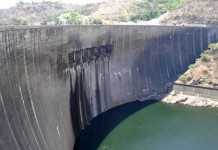Australian searchers have relocated an underwater electronic signal that could be from the missing Malaysian jetliner in the Indian Ocean, the search coordinator says, allowing them to narrow the focus of their effort to find wreckage.
Angus Houston, who is leading the joint search, said in Perth on Wednesday that equipment aboard the Australian ship Ocean Shield twice reacquired signals first detected last week that could be coming from the black box data and voice recorders on board the missing Malaysian Airlines Flight 370.
He said the ship has now heard the signal a total of four times, most recently a seven-minute transmission Tuesday night.
The new data has allowed searchers to further reduce the size of the search area, Houston said.
“I believe we are searching in the right area” for the wreckage, he said.
But searchers are in a race against time, trying to gain as much information from the underwater signals as they can before the onboard batteries — already past their expected lifespan — expire and the data recorder pingers go silent.
It’s been 33 days since the plane was lost on a flight from Kuala Lumpur to Beijing, and Houston noted that the expected timelifeof the batteries on the black box pingers is 30 days.
“It is important that we gather as much information …. while the pingers are still transmitting,” he said.
“The last signal we got was a very weak signal,” he said.
Before Wednesday’s report by Houston, search crews had last heard the signals early Sunday.
Australian officials said 14 ships and 15 planes were resuming the search with scattered showers in the forecast for the current search zone, which measures some 46,000 square miles.
Tuesday’s search effort wrapped up with no report of additional signals.
“There is no way you can get around it, that is a setback,” Peter Goelz, a former managing director of the National Transportation Safety Board, told USA TODAY. “I think we could be talking about months if not years of searching. This is hard work.”
During a press conference Tuesday in Perth, Australia, Minister of Defense David Johnston said crews were prepared to deploy a small submersible vessel as soon as they receive another ping transmission. The black box’s ping batteries, however, are reaching their limit.
“I think they (authorities) have to continue with the pinger search for another week or 10 days,” Goelz said. “After that, they have to reassess how they will search and who will pay for it.”
The sub, or similar technology, could be the only way, he said.
The underwater vehicle, the Bluefin 21 unmanned sub, is loaded with equipment that can create a sonar map of an area to chart any debris on the sea floor. But it works slowly, so the search area must be sharply trimmed first. Authorities have narrowed the search, but it remains focused on an area nearly 30,000 square miles in size while more clues are sought.
“This is the most positive lead we’ve had, and as I’ve said, we are pursuing it aggressively,” Johnston said of the pings detected Saturday and Sunday.
The cost of the effort rises each day. Estimates compiled by Reutersshow that Australia, China, the United States and Vietnam have already spent at least $44 million on the deployment of military ships and aircraft.
The news service said the total does not include the aid from countries including Britain, France, New Zealand and South Korea, or numerous other costs such as civilian aircraft, accommodation for hundreds of personnel and expenses for intelligence analysts.
The intense air and sea search Tuesday included 14 planes and 14 ships operating in good weather conditions off Australia’s western coast, search coordinators said in a statement issued Tuesday in Perth.
Angus Houston, who is heading the search off Australia’s coast, has warned that it could be days before authorities determine whether the signals came from the cockpit voice and data recorders on board Flight 370, which was lost early March 8 after departing Kuala Lumpur, Malaysia, with 239 people aboard bound for Beijing.
The Ocean Shield picked up the signals using a U.S. Navy device called a towed pinger locator, which is pulled behind the ship at a depth of about 2 miles.
The pinger locator is designed to detect signals at a range of 1 mile, meaning it would need to be almost on top of the black boxes to detect them if they were on the ocean floor.
The Ocean Shield is continuing to comb the ocean, trying to find the signal again.
“The connections two days ago were obviously a time of great hope that there had been a significant breakthrough and it was disappointing that we were unable to repeat that experience,” said Warren Truss, Australia’s acting prime minister.
Additionally, a Chinese search vessel, Haixun 01, also said it briefly heard signals over the weekend. Those signals, more than 300 miles from the other signals, were being investigated by a British naval vessel, HMS Echo, which also has sophisticated listening technology.
USATODAY.com

 JOIN DRIVERN TAXI AS PARTNER DRIVER TODAY!
JOIN DRIVERN TAXI AS PARTNER DRIVER TODAY!












Jst ask the CIA… They know where the plane.. It is boeing plane!!!!